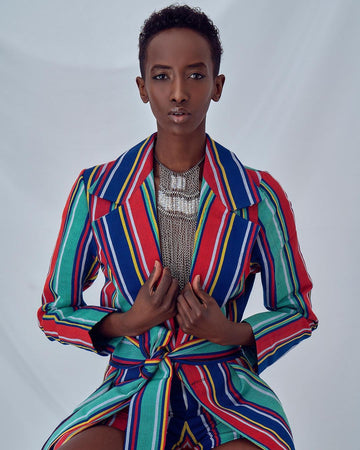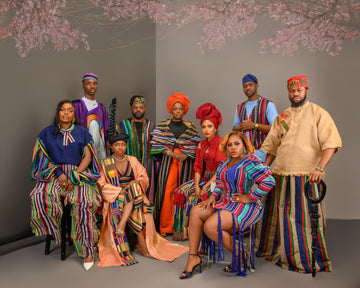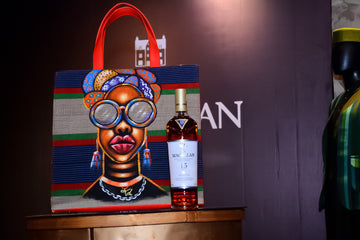La Journée de l'Afrique est célébrée chaque année le 25 mai pour commémorer la création de l'Organisation de l'unité africaine en 1963. Elle est célébrée dans divers pays d'Afrique et du monde entier pour honorer l'unité et le progrès du continent.
La Journée de l'Afrique est l'occasion de célébrer les cultures, les histoires et les réalisations dynamiques du continent africain. En matière de mode africaine, il y a tant à commémorer. La tradition du tissage des vêtements, les tissus, le processus et le style. L'un des symboles les plus emblématiques du patrimoine africain est l'Aso-Oke , un tissu traditionnel qui incarne l'esprit et le savoir-faire du peuple Yoruba. Connu sous le nom d'Aso Ofi, qui se traduit par « tissu créé sur un métier à tisser en bois », l'Aso-Oke témoigne de l'art intemporel transmis de génération en génération.

L'histoire d'Aso-Oke

Originaire de la ville d'Iseyin, dans l'État d'Oyo, au Nigéria, l'Aso-Oke est le tissu traditionnel du peuple Yoruba, ce qui signifie « tissu de l'intérieur du pays » . Tissé à la main à partir de fibres et de coton brut, l'Aso-Oke est un textile qui se classe au premier rang des tissus indigènes d'Afrique. Mais ce n'est pas seulement le matériau qui le rend spécial. C'est le processus méticuleux, les mains expertes des artisans, qui le transforment en une œuvre d'art. De la récolte et de la transformation du coton à la filature en fils et à la teinture en couleurs riches et vibrantes, chaque étape témoigne de leur talent artistique. Transmise de père en fils, cette forme d'art ancienne est ancrée dans la trame même de notre identité culturelle.
La tradition de l'Aso-Oke

Saviez-vous?
Saviez-vous que traditionnellement, il était interdit aux femmes de tisser l’Aso-oke ou de travailler sur le métier à tisser ?
Cette pratique n’était pas due à la méchanceté ou au patriarcat, mais au souci de leur bien-être. La posture requise pour se pencher sur un métier à tisser était jugée inadaptée, en particulier pour les femmes enceintes. Bien que les femmes jouaient un rôle crucial dans l’enfilage et d’autres étapes du processus de fabrication du tissu, il était rare de les voir sur le métier à tisser. Cette tradition met en évidence le soin apporté pour assurer la santé et la sécurité des femmes tout en préservant l’art complexe du tissage Aso-oke.
Bien que la tradition ait autrefois limité le rôle des femmes dans le tissage de l'Aso-Oke, l'essence même de ce tissu a toujours été l'inclusion et l'autonomisation des femmes. Même si les hommes étaient les principaux tisserands, les femmes ont apporté leurs talents uniques à d'autres parties du processus, ajoutant leur touche féminine et leur grâce au produit final.
Aso-Oke Le symbole de l'autorité et de l'élégance

Tout au long de l'histoire, l'Aso-Oke a été synonyme d'autorité, de richesse et de classe. C'est le tissu de prédilection des personnalités notables, un symbole de sophistication et de goût raffiné. Des cérémonies royales aux mariages somptueux, aucune occasion de valeur n'est complète sans la présence de l'Aso-Oke, qui rehausse chaque moment de son allure royale. Il était courant de voir les chefs et les rois couronnés utiliser l' Aso-Oke « Sanyan » . L'« Etu », un aso-oke rayé bleu indigo, était couramment porté par les anciens. L'« Alaari » était de couleur cramoisie, le « Takunsi » était à motifs, entre autres.
Aso-Oke dans la mode contemporaine
L'Aso-oke est passé du statut de tissu traditionnel yoruba utilisé pour les cérémonies à celui d'élément incontournable de la mode africaine moderne. Cette évolution met en évidence la polyvalence et l'attrait durable du tissu.

Aujourd'hui, lors des mariages, tant au sein de la communauté yoruba qu'à l'extérieur, les couples se distinguent par des pièces aso-oke bien coupées et façonnées. Les hommes portent leur Agbada, tandis que les femmes les portent en robe ou en jupe et chemisier, ornant leur tête de « Gele » et leurs épaules d'« Ipele ».
Aujourd'hui, les créateurs intègrent l'Aso-oke dans leurs créations contemporaines, en mélangeant héritage et style quotidien. Trax en est un exemple notable, utilisant l'Aso-oke pour créer des pièces tendance du quotidien. Inspiré par le riche héritage de l'Aso-Oke, Trax intègre fièrement l'Aso-Oke dans ses créations. C'est comme prendre un morceau d'histoire et le fusionner avec de la personnalité pour créer une mode africaine contemporaine vraiment unique.
Notre approche unique comprend des pièces Aso-oke peintes à la main, ajoutant une signification culturelle à leurs créations. Ces pièces mettent non seulement en valeur l'expression artistique, mais célèbrent également l'artisanat et la tradition africaine.
Les pièces Aso-oke peintes à la main de Trax illustrent la manière dont les tissus traditionnels peuvent s'adapter à la mode moderne, les rendant pertinents pour le public d'aujourd'hui tout en préservant leur essence culturelle.
Célébration de la Journée de l'Afrique avec Aso-Oke
La Journée de l'Afrique est l'occasion idéale de célébrer l'héritage africain à travers la mode. Incorporer l'Aso-oke dans votre tenue est une belle façon d'honorer cette riche tradition culturelle. Voici quelques conseils et idées de style pour vous aider à intégrer l'Aso-oke dans vos célébrations de la Journée de l'Afrique :
Idées de style pour les femmes
Aso-Oke deux pièces


Optez pour une touche Aso-oke élégante qui allie motifs traditionnels et coupes contemporaines.


Ces ensembles offrent à la femme moderne la possibilité de se sentir aussi royale et sophistiquée que possible tout en arborant un morceau de son héritage africain. Ils sont parfaits pour toutes les occasions, des fêtes au bureau. Associez-les à des bijoux tendance et à des talons confortables pour un look chic.
Pantalon Aso Oke


Pour un look plus décontracté, associez un pantalon Aso-oke à un crop top ou à n'importe quel haut de votre choix. Ce mélange de styles traditionnels et modernes crée un ensemble unique et accrocheur.
Jupes Aso-Oke


Associez vos hauts simples à une touche culturelle vibrante : les jupes Aso-oke. Trax propose différentes options en matière de jupes Aso-oke, longues ou courtes, spectaculaires ou simples. Choisissez votre style.
Accessoires Aso Oke


Une autre façon amusante de porter l'aso-oke est d'utiliser une pièce phare incorporée à votre tenue de tous les jours. Une ceinture, un couvre-chef, une brassière, des sacs et même des chaussures.
Idées de style pour hommes
Vestes Aso-Oke


Portez une veste Aso-oke sur une chemise unie et un pantalon. Cette pièce tendance vous permettra de vous démarquer et d'honorer la tradition avec style.
Bas Aso-Oke


Associez un pantalon ou un short Aso-oke à une chemise et un pantalon unis. Cette pièce tendance vous permettra de vous démarquer et d'honorer la tradition avec style.
Accessoires Aso Oke


Incorporez des accessoires Aso-oke tels que des chapeaux, des ceintures ou des pochettes pour infuser subtilement votre tenue d'éléments culturels.
Honorer le patrimoine africain à travers la mode
La mode est un moyen puissant de célébrer et de préserver le patrimoine culturel. Heureusement, la mode africaine occupe la scène internationale comme elle le devrait.
À l’occasion de la Journée de l’Afrique, laissez votre style refléter la richesse de la culture africaine. Adoptez cet héritage, portez-le avec fierté et inspirez les autres à faire de même.






